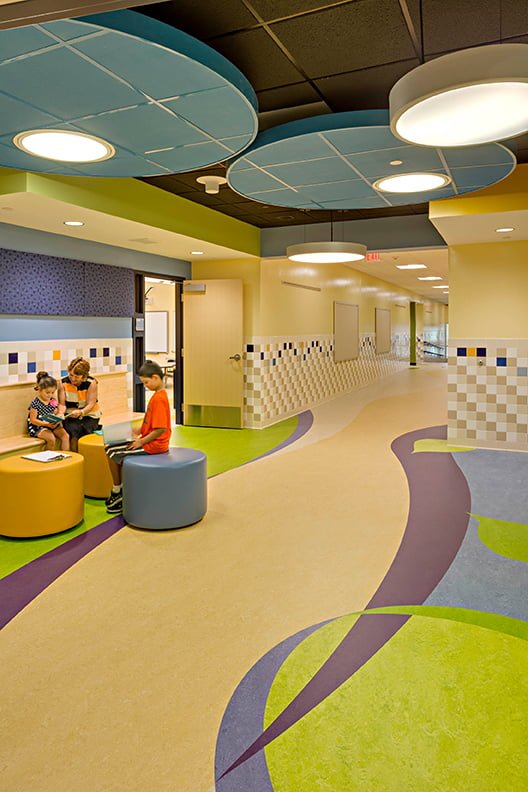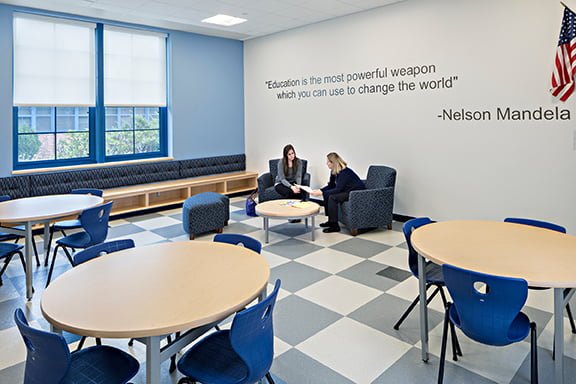Furniture Completes the Learning Environment for Students
When contemplating the design of each of the learning spaces within a school, the touchstone for every decision should be the end users of each space – the students. Students, teachers, and administrators utilize the facility throughout the day, but the students typically have the widest range of body sizes and shapes, the least amount of freedom to move about as they desire and are experiencing both physical and emotional growth at sometimes alarming rates.
For students, the school-age years are a time of steady growth and development. Staying physically active during this phase of their lives is not only a natural inclination – so many times we hear a child admonished to ‘sit still’ – but also serves to strengthen the fundamental skills needed to lead a healthy and active life as an adult. While growing physically is a natural phenomenon, the social development taking place during the school-age years is arguably more important, and more dependent upon environment as well.

Successful classrooms support both social development and academic success. Teachers and aides encourage cooperation and collaboration amongst students by structuring learning activities where children work together on a specific task or project.1 Furniture within the learning space that is accommodating of the range of physical sizes of the students could be considered the minimal threshold.
Measurements have shown that students with the same body height can have a range of lower-leg lengths. One standard size seat and desk does not provide an ideal for a wide range of students. Therefore, it is important that the optimum seat height for students is based on the actual measurements of lower leg length. The chair height should be selected so that the front edge of the seat is in line with the bottom of the student’s knee. Both feet should have full contact with the floor. There should be three to four fingers of space between the front of the chair and the back of the knees. The back of the chair should be contoured so that it is supporting the student’s spine.2
In addition to physical comfort, the learning opportunities present within a classroom shape the selection of furniture as well. Desks and tables that support individual, pairs, and group work by students will lend flexibility to the teacher during lesson planning and promote the 4 Cs – collaboration, communication, creativity, and critical thinking amongst students. As with chairs, a variety of desk heights is key to creating a classroom where learning is uninhibited by the environment. Providing at least one adjustable height desk within each classroom will provide a breakout area within the space where students can stand while working, allowing them to stretch, move about, and burn off some energy without leaving the room.
Computer use within schools has become ubiquitous, with one to one computing in all grades seen as a foregone conclusion by many. This has the effect of moving students out of dedicated computer labs and the strict structure of those spaces and into maker spaces, STEM rooms, and outdoors. This means the chairs and desks a student will use must be able to support a full range of learning modalities while remaining light weight so as to be easily rearranged.
Through their daily contact with parents, care givers, family members, school staff, and their peers, children learn about the social world and about the rules, practices and values that support it. By actively participating in these relationships, children also affect the ways that adults and their peers relate to them.3
 Social development refers to the process by which a child learns to interact with others around them. As they develop and perceive their own individuality within their community, they also gain skills to communicate with other people and process their actions. Social development most often refers to how a child develops friendships and other relationships, as well how a child handles conflict with peers. Three particular areas of school life provide significant opportunity for social development – physical education/sports, the media center, and dining. Of these, the media center and dining can be substantially impacted by furniture choices.
Social development refers to the process by which a child learns to interact with others around them. As they develop and perceive their own individuality within their community, they also gain skills to communicate with other people and process their actions. Social development most often refers to how a child develops friendships and other relationships, as well how a child handles conflict with peers. Three particular areas of school life provide significant opportunity for social development – physical education/sports, the media center, and dining. Of these, the media center and dining can be substantially impacted by furniture choices.
The modern school media center promotes learning in ways that may have seemed out of place in the library of the past. A move toward incorporating the social aspects of Starbucks into the media center has prompted many schools to forego the ‘no food or drinks’ dictate and throw study carrels to the side in favor of coffee bars and movable soft seating. Elementary age students may now see a library with a heated floor, throw rugs, bean bags, and more traditional style chairs all sharing the same area. This prompts them to make themselves comfortable in whatever manner suits them best.
The cafeteria has perhaps lagged the farthest behind when it comes to selecting furniture that promotes learning. Exchanging ideas while dining is a societal norm in virtually all cultures. As adults we routinely meet for a business lunch or for dinner with friends. Within the confines of our schools, however, we too often miss the opportunity to create truly dynamic and engaging learning environments by reverting to folding tables with fixed seats. Promoting personal interaction, discipline, and courtesy by providing separated chairs in a variety of sizes, with round tables of not more than eight places, has been shown to return benefits to students and staff.
References:
1 KidsMatter – www.kidsmatter.edu.au
2 Bodies in Motion. Brains in Motion. Author Dr. Dieter Breithecker, V/S Furniture
3 Social Development in Children, Stop Child Abuse Now (SCAN) of North Virginia – www.scanva.org

